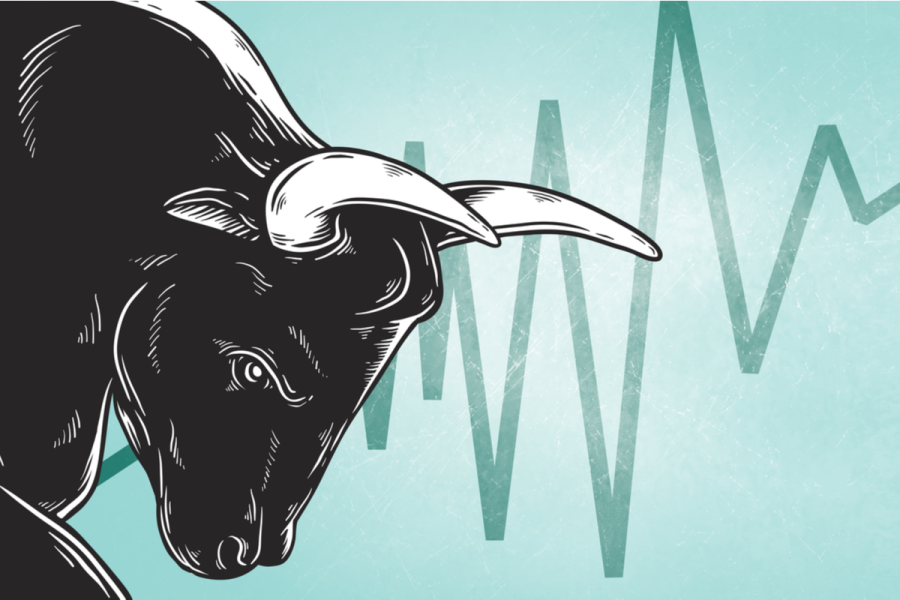Columns
Interest rates are not everything
It is folly to invest solely because rates are low and shy away because rates are rising.
Paban Raj Pandey
No two bull markets are alike, yet they all share a common thread—optimism. Reasons for optimism can be varied, but the end result is the same—rising prices. Sometimes, this is matched by sound economic fundamentals and improving earnings, and sometimes not. There are times when prices begin to diverge from fundamentals. It is times like these that investors begin to grasp for things that they can massage to suit their own biases. Nepal’s stock market is in a strong bull trend currently, which increasingly many attribute to a drop in interest rates. The fact is that low interest rates are symptoms of the times—that of sluggish economic activity and deposits growing faster than loans.
The Nepal Stock Exchange (NEPSE) bottomed at 1150 on June 29 last year, before surging 130 percent in less than eight months! This comes after four long years of consolidation. In July 2016, the index retreated after hitting 1888. It then bottomed at 1099 in March 2019. The ongoing rally has taken place at a time when the economy is in a shambles. Investors clearly are looking beyond the current hardship. Time will tell if they will be rewarded for their optimism or have priced in too much good news. But, as is true with any bull market, the longer the optimism persists, the better it is for those with skin in the game. Bulls’ emphasis on low interest rates is an attempt to keep the optimism train going.
Bulls’ interest-rate spin
Interest rates are down across the board. Pre-pandemic, the economy was strong, with the growth of 7 to 8 percent for three consecutive years through 2018-19. The 2019-20 budget, for the fiscal year ending mid-July last year, expected the momentum to continue, with a goal of 8.5 percent growth. Then Covid-19 hit. Economic activity ground to a halt. At one time, excess liquidity in the banking system amounted to Rs200 billion, putting downward pressure on rates. On a weighted average basis, per Nepal Rastra Bank, the rate on fixed deposits went from 9.7 percent last April to 8 percent and on savings deposits from 4.7 percent to 2.8 percent, even as the lending rate went from 11.8 percent to 9.1 percent.
In order to boost demand, banks and financial institutions aggressively lowered rates on home and auto loans, and margin loans, among others. Because margin loans are issued against the collateral of securities, banks consider them low risk as they can quickly dispose of them at the first sign of trouble; banks currently can also lend out 70 percent of the value of shares, which was raised from 65 percent when the 2020-21 monetary policy was announced last July. Margin loans have taken off—from Rs50.4 billion at the end of last fiscal (mid-July 2020) to Rs75.7 billion in mid-January this year. Lower rates have gone a long way in boosting investors’ risk-on attitude.
In finance, the discounted cash flow model is a widely used tool to value assets. The value of an investment is determined based on its future cash flows whose present value is arrived at by using cost of capital. In essence, the lower the discount rate, the higher the cash flows. Similarly, in commercial real estate, the capitalisation rate (also known as the cap rate) is calculated by dividing a property’s net operating income by the current market value. The rate also implies the amount of time required to recover the invested amount in a property; a cap rate of 7 percent will take around seven years to recover the investment. Basically, the higher the cap rate, the lower the market value, and vice versa.
The point is, lower rates help valuations, no doubt. At the most basic level, lower rates are a boon for borrowers. So, when a stock investor says low rates are good, he is talking from a borrower’s perspective. If a hydropower company with a loan book of Rs10 billion sees rates drop from 12 percent to 9 percent, it just saved Rs300 million a year that could be used to pay off debt or pay out dividends. But this is one side of the story. Savers suffer in a low-rate environment. Ask a retiree living on income from fixed deposits. Since the global financial crisis of 2008-09, as interest rates nosedived—and stayed there—this has been a nagging concern for savers in developed economies such as the United States.
Removal of excess liquidity
That said, if rates had an outsize influence on valuations, eurozone stocks would be much higher. The German DAX has pretty much gone sideways the past three years. One of the offshoots of the financial crisis is negative rates, where borrowers get paid to borrow while savers pay to deposit. The idea is to encourage investment and risk-taking. Currently, rates are negative in the eurozone, Japan, Switzerland, Denmark, and Sweden.
The irony is, interest rates—the main policy tool for these banks—have ceased to induce the same response as in the past. In normal times, rates rise in a growing economy. But because more people are working and companies are earning more, stocks do just fine. Rates also rise in an inflationary environment. Many developed economies experienced stagflation during the 1970s. In the US, consumer inflation peaked at 13-14 percent in 1980, and the fed funds rate—the benchmark interest rate—crossed 19 percent in 1981; the economy suffered two recessions each early in the 1970s and 1980s, and stocks tanked. The message in all this is that there is no one-size-fits-all model when it comes to how interest rates impact stocks.
In Nepal, bank loans in recent weeks have grown faster than deposits. If the current trend persists, the excess liquidity will have been mopped up in due course, which can then put upward pressure on rates. The NEPSE is not worried by these prospects. On February 18, it reached a new intraday high of 2642. It is sheer folly to invest solely because rates are low and shy away because rates are rising. Many times, it is the speed of a change in rates that counts. For an average mortgage owner, a rise in a monthly payment of Rs500 may be ok, but not if it goes up Rs5,000. Ironically, it should surprise no one if bulls next begin to argue that rising interest rates reflect better days ahead, and that it is good for stocks.
***
What do you think?
Dear reader, we’d like to hear from you. We regularly publish letters to the editor on contemporary issues or direct responses to something the Post has recently published. Please send your letters to [email protected] with "Letter to the Editor" in the subject line. Please include your name, location, and a contact address so one of our editors can reach out to you.




 13.12°C Kathmandu
13.12°C Kathmandu















